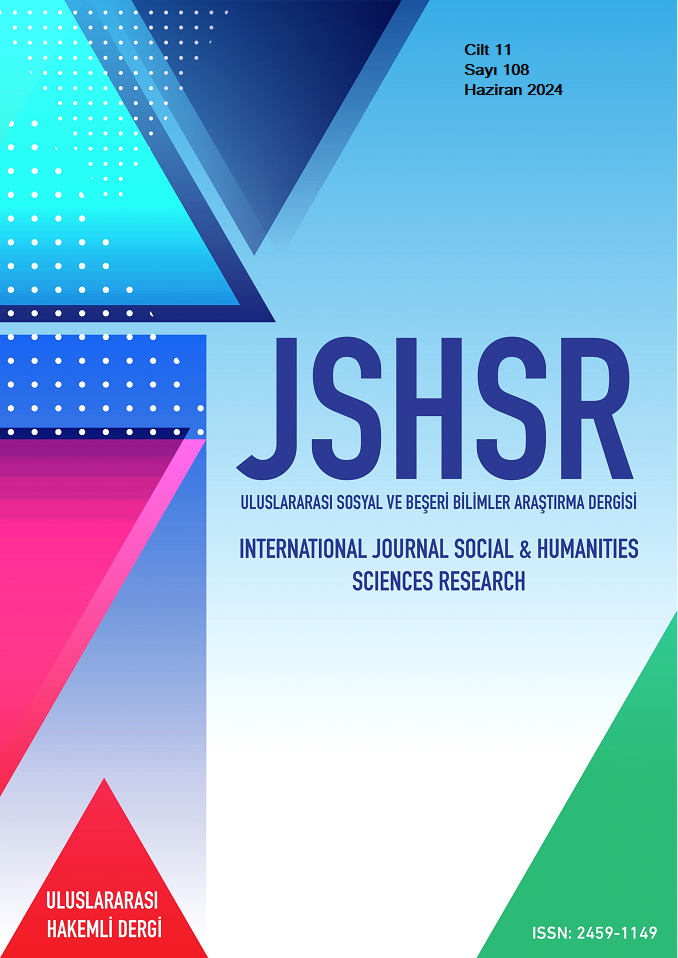Introducing Historical Values with Comics: Scientists Comic Series
DOI:
https://doi.org/10.5281/zenodo.12603269Keywords:
Turkish education., Value, Children's Literature, ComicsAbstract
The examination element of this research was created by the Ministry of National Education in order to provide students with this information in a comic book genre rich with visual stimuli in order to enable them to comprehend the contributions of important figures who have become part of history to the world and humanity. The use of comic books in education is very important. Using the tools that children love in education facilitates learning. Materials enriched with visuals are also elements that attract attention and make learning enjoyable. It is important to benefit from these resources in in-class and out-of-class activities. One of the literary genres that includes all of these features is the comic book. This research, it was aimed to introduce scientists to students through the comic book genre and to provide historical knowledge and consciousness with these works and to transfer values through works. The first works of the prepared series, Evliya Çelebi, Harizmi and Cezeri comic books, aimed to provide a rich learning experience to all students, especially middle school students, about the characteristics of the period in which the hero lived, social and cultural structures. Content analysis, one of the qualitative research methods, was used in the research. Works used in the research were accessed from the official website of the Ministry of National Education. As a result of the research, it is seen that it is appropriate to read these comics as an educational source that can be used to introduce and endear the figures that shaped our history. The works have presented the lives of important figures who contributed to our history, science, culture and art world to students in different ways, and it is aimed to attract their attention with visual richness. While doing this with comics, they have managed to introduce these values without alienating them from the essence of our national culture.
References
Akdağ, S. (2023). Uzaktan öğretimle sosyal bilgiler dersinde eğitici çizgi roman kullanımının öğrencilerin bilişsel ve duyuşsal öğrenmelerine etkisinin incelenmesi. [Yayımlanmamış Doktora Tezi]. Eğitim Bilimleri Enstitüsü, Atatürk Üniversitesi.
Arı, A., Demir, B., & Işık, B. B. (2019). Matematik eğitiminde manga çizgi roman kullanımı. Bayburt Üniversitesi Fen Bilimleri Dergisi, 2(2), 261-265.
Arslan, K. & Akçay. H. (2022). Çizgi romanla fen bilimleri öğretiminin öğrenci başarısına etkisi. Bilim Eğitim Sanat ve Teknoloji Dergisi, 6(1), 14-31.
Aslan, G. B. (2019). Türkiyede çizgi roman sanatının gelişim süreci içerisinde Turhan Selçukun yeri ve Abdülcanbaz. [Yayımlanmamış Yüksek Lisans Tezi]. Sosyal Bilimler Enstitüsü, Haliç Üniversitesi.
Aytekin, H. (2011). Harry Potter ve Felsefe Taşı’nda üslup ve mizah. Erciyes Üniversitesi Sosyal Bilimler Enstitüsü Dergisi, 1(30),167-184.
Ayyıldız N (2010). Coğrafya öğretiminde karikatür materyali kullanımının öğrenci başarısına etkisi. [Yayımlanmamış Doktora Tezi]. Sosyal Bilimler Enstitüsü, Marmara Üniversitesi.
Balım, A.G., İnel, D., & Evrekli, E. (2008). Fen öğretiminde kavram karikatürü kullanımının öğrencilerin akademik başarılarına ve sorgulayıcı öğrenme becerileri algılarına etkisi. İlköğretim Online, 7(1), 188-202.
Bilgin, N. (2006). Sosyal Bilimlerde İçerik Analizi Teknikler ve Örnek Çalışmalar. (2. Baskı). Siyasal Kitabevi.
Boyraz, C. (2022). Çocuklar için felsefe eğitiminde uyaran olarak çizgi filmlerin kullanımı: Vikingler ve Heidi. Erciyes Journal of Education, 6(2), 127-144.
Cantek, L. (2014). Türkiye’de Çizgi Roman. İletişim Yayınları.
Cary, S. (2004). Going Graphic: Comics At Work İn The Multilingual Classroom. Portsmounth NH (ABD): Heinemann.
Creswell, J. W. (2003). Research design: Qualitative, quantitative, and mixed methods approaches (2nd ed.). Thousand Oaks, CA: Sage.
Ekiz, D. (2015). Bilimsel Araştırma Yöntemleri Yaklaşım, Yöntem ve Teknikler. Anı Yayıncılık.
Ertemsir E. (2011). Yükseköğretimde yöneticilik eğitimi ve yeni bir öğretim yöntemi olarak interaktif çizgi roman: yöntemin yarattığı faydalılık algısı üzerine bir araştırma. [Yayımlanmamış Doktora Tezi]. Sosyal Bilimler Enstitüsü, İstanbul Üniversitesi.
Gravett, P. (201). Comics Art. Yale University Press.
Halis, İ. (2002). Öğretim Teknolojileri ve Materyal Geliştirme. Nobel Yayıncılık.
Hands, T., Shaw, A., Gibson, M., & Miller, K. (2018). People and their plants: The effect of an educational comic on gardening ıntentions. Urban Forestry and Urban Greening, 30, 132-137.
Karataş, Z. (2015). Sosyal bilimlerde nitel araştırma yöntemleri. Manevi Temelli Sosyal Hizmet Araştırmaları Dergisi, 1(1), 62-80.
McCloud, S. (2019). Çizgi Romanı Anlamak (Çev. Ülgen M.Cem). Sırtlan Kitap.
MEB. (2024). Bilim İnsanları Çizgi Roman Serisi. https://tegm.meb.gov.tr/www/bilim-insanlari-cizgi-roman-serisinin-ilk-kitaplari-yayimlandi/icerik/929
Morel, M., Peruzzo, N., Juele, A. R. & Amarelle, V. (2019). Comics as an educational resource to teach microbiology in the classroom. Journal of microbiology & biology education, 20(1). https://doi.org/10.1128/jmbe.v20i1.1681
Oymak, R. (2018). Dil, düş, düşünce gelişiminde çizgi kitap ve çocuk. Journal of Institute of Economic Development and Social Researches. 4(10), 460-472.
Öz, C. (2013). Moda tasarımı eğitimi alan lisans öğrencilerinin popüler kültür ürünü olan çizgi romanın ve kahramanlarının günümüz modası ve yaratıcılıklarına etkilerine dair görüşleri. [Yayımlanmamış Yüksek Lisans Tezi]. Eğitim Bilimleri Enstitüsü, Gazi Üniversitesi.
Symeon, R. (2008). State of the art comics in education. Using web comics in education. Project deliverable report. (http://www.educomics.org/material/deliverables/Deliverable1_Stateofthe Art.pdf ).
Tilley, C. L., & Weiner, R. G. (2017). Teaching and learning with comics. In F. Bramlett, R. T. Cook, & A. Meskin (Eds.), The Routledge companion to comics (pp. 358–366). New York: Routledge.
Weber, K. C., Saldanha, T. C. B., De Sousa E Sılva, K. K., Santos, P. M. M., vd. (2013). Introducing comics as an alternative scientific narrative in chemistry teaching. Batı Anadolu Eğitim Bilimleri Dergisi, 4(8), 1-14.
Wood, M. (2015). The effect of graphic novel supplements on reading comprehension and motivation in secondary students. [Unpublished doctoral dissertation]. University of Central Arkansas.
Yalçın, A. & Aytaş, G.(2008). Çocuk Edebiyatı(2. baskı). Akçağ Yayınları.
Yıldırım, E. (2016). Sınıf öğretmeni adaylarının eğitici çizgi roman hakkındaki görüşlerinin incelenmesi. Kilis 7 Aralık Üniversitesi Sosyal Bilimler Dergisi, 6(11), 52-70.
Yıldırım, A. & Şimşek, H. (2018). Sosyal Bilimlerde Nitel Araştırma Yöntemleri. Seçkin Yayınları.
İncelenen Eserler:
Dündar, E. (2024). Hârizmi. MEB Yayınları.
Dündar, E. & Varlı, N. N. (2024). Cezeri. MEB Yayınları.
Varlı, N. N. (2024). Evliya Çelebi. MEB Yayınları.
Downloads
Published
How to Cite
Issue
Section
License
Copyright (c) 2024 INTERNATIONAL JOURNAL OF SOCIAL HUMANITIES SCIENCES RESEARCH

This work is licensed under a Creative Commons Attribution 4.0 International License.


